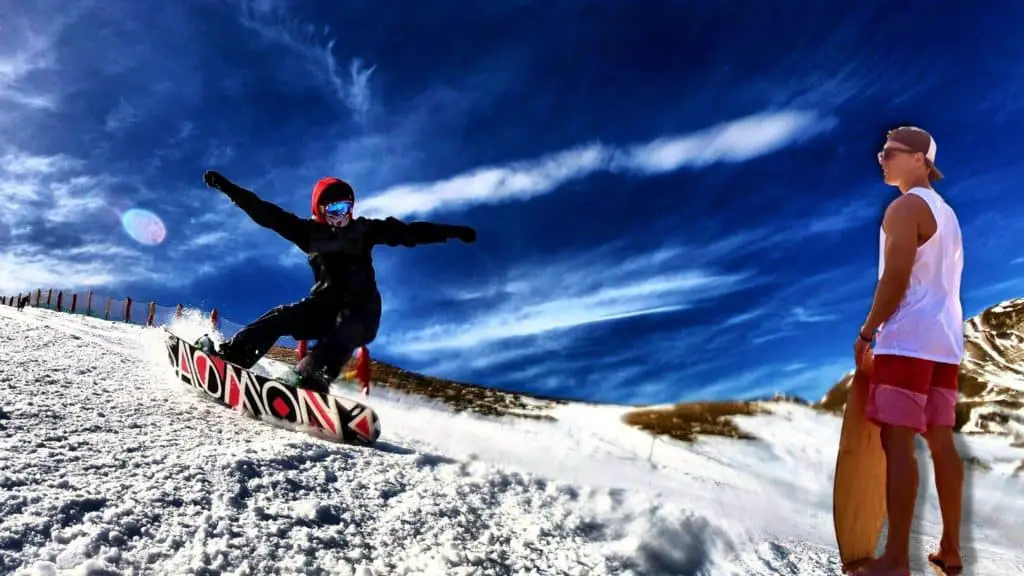Skimboarding is a lot of fun, and can you can do it pretty much anywhere there’s water. But what about when it snows?
You might think that the answer to this question is no, but in reality, it’s possible!
There are many reasons you might want to give skimboarding on snow a try so let’s conquer this mountain of a question in this article!

Yes, it is possible to skimboard on snow, but you will need to find a suitable location with packed-down snow. Flat terrain won’t give you enough speed to make your board glide across the snow. It’s also essential to have all the necessary safety gear, such as a helmet and knee pads, like with your snowboard.
In this post we'll cover:
Why snow skimming is possible
The science behind skimboarding is pretty simple. When you ride a skimboard, your weight presses down on the board.
The weight creates friction between the board’s bottom and the water, which gives you the power to glide across the surface.
The same concept applies to snowy mountains! By pressing down on your board, you can create enough friction to make it glide across the snow.
You can skimboard many surfaces, like wet grass, lakes, and puddles, and it seems even snow!
However, there are a few things you need to take into account before you hit the slopes.
Snow powder and downhill challenges
First of all, you need to make sure that the snow is packed down enough so that your board can create enough friction.
If the snow is too loose, you’ll sink into it.
An excellent way to test this is to take a handful of snow and try to compress it into a ball.
If it’s too difficult to do so, then the snow isn’t packed enough, and you won’t be able to skimboard on it.
Another thing to keep in mind is that you’ll need to find a hill to ride down.
Flat terrain won’t give you enough speed to make your board glide across the snow.
Once you’ve found a good location, it’s time to get started!
You can get a little bit of skimming going when you run and drop your board, but getting up a lot of speed on snow can be pretty challenging as running is slippery.
Ensure you have all the necessary safety gear, such as a helmet and knee pads, just as you would with a snowboard. Skimboarding downhill is a lot more challenging!
Then, position your board at the top of the hill and get ready to go!
When you’re ready, press down on your board to create friction and glide down the hill.
You might need to experiment to find the right balance of speed and pressure, but you’ll eventually get the hang of it!
Differences between a skimboard and a snowboard
Now that you know how to skimboard on snow, you might be wondering what the difference is between a skimboard and a snowboard.
The most significant difference is in the design of the boards.
A skimboard is much smaller and lighter than a snowboard, making it easier to maneuver.
For skimming on snow, you’ll want to use a board designed for flatland skimboarding or inland skimboarding which is designed for use on smooth surfaces like sidewalks or skateparks.
That’s a little more like a snowboard than say a skimboard designed to ride waves and is more like skateboarding than surfing at the beach.
A snowboard, on the other hand, is bigger and heavier.
It’s also designed specifically for riding down hills and slopes.
Another big difference is that skimboards don’t have bindings, so your feet are not attached to the board.
This gives you more flexibility and allows you to do skimboarding tricks that you wouldn’t be able to do on a snowboard.
You can get airtime separate from your board, which you wouldn’t be able to do on a snowboard.
Not having bindings makes it harder to keep on your board, so you shouldn’t go onto any steep slopes with your skimboard. You’ll most definitely fall off at high speeds.
With snow skimming, it will be more about the tricks than a speedy descent.
What makes skimboarding on snow difficult?
Skimboarding on snow can be pretty tricky, especially if you’re used to riding on water.
The biggest challenge is keeping your balance.
Since your feet are not attached to the board, it’s easy to lose your footing and fall off.
Another big challenge is finding the right location.
As we mentioned before, you need to find a hill or slope that’s not too steep and has packed down snow.
If the snow is too loose, you won’t be able to get enough friction to make your board glide.
And if the slope is too steep, you’ll lose control of your board and most likely fall off.
So, it definitely takes some trial and error to find the perfect spot for skimboarding on snow!
Conclusion
Skimboarding on snow is a great way to enjoy the winter months.
It is a lot of fun, but it’s also a great workout.
So what are you waiting for? Get out there and give it a try!
Also read: skimboarding explained, this is what you need to know

